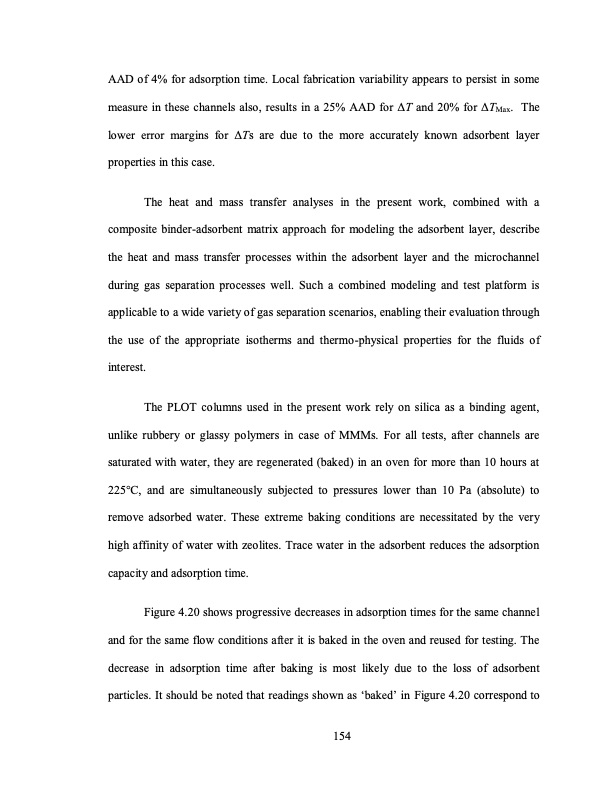
PDF Publication Title:
Text from PDF Page: 181
AAD of 4% for adsorption time. Local fabrication variability appears to persist in some measure in these channels also, results in a 25% AAD for ΔT and 20% for ΔTMax. The lower error margins for ΔTs are due to the more accurately known adsorbent layer properties in this case. The heat and mass transfer analyses in the present work, combined with a composite binder-adsorbent matrix approach for modeling the adsorbent layer, describe the heat and mass transfer processes within the adsorbent layer and the microchannel during gas separation processes well. Such a combined modeling and test platform is applicable to a wide variety of gas separation scenarios, enabling their evaluation through the use of the appropriate isotherms and thermo-physical properties for the fluids of interest. The PLOT columns used in the present work rely on silica as a binding agent, unlike rubbery or glassy polymers in case of MMMs. For all tests, after channels are saturated with water, they are regenerated (baked) in an oven for more than 10 hours at 225°C, and are simultaneously subjected to pressures lower than 10 Pa (absolute) to remove adsorbed water. These extreme baking conditions are necessitated by the very high affinity of water with zeolites. Trace water in the adsorbent reduces the adsorption capacity and adsorption time. Figure 4.20 shows progressive decreases in adsorption times for the same channel and for the same flow conditions after it is baked in the oven and reused for testing. The decrease in adsorption time after baking is most likely due to the loss of adsorbent particles. It should be noted that readings shown as ̳baked‘ in Figure 4.20 correspond to 154PDF Image | TEMPERATURE SWING ADSORPTION PROCESSES FOR GAS SEPARATION

PDF Search Title:
TEMPERATURE SWING ADSORPTION PROCESSES FOR GAS SEPARATIONOriginal File Name Searched:
PAHINKAR-DISSERTATION-2016.pdfDIY PDF Search: Google It | Yahoo | Bing
CO2 Organic Rankine Cycle Experimenter Platform The supercritical CO2 phase change system is both a heat pump and organic rankine cycle which can be used for those purposes and as a supercritical extractor for advanced subcritical and supercritical extraction technology. Uses include producing nanoparticles, precious metal CO2 extraction, lithium battery recycling, and other applications... More Info
Heat Pumps CO2 ORC Heat Pump System Platform More Info
| CONTACT TEL: 608-238-6001 Email: greg@infinityturbine.com | RSS | AMP |